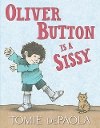In Memoriam: Tomie dePaola (1934–2020)
The first thing I think of when I think of Tomie dePaola (who died in March at the age of eighty-five, from complications following a fall) isn’t a book at all. It’s Christmas. I think of a Tomie dePaola nativity set my family had growing up.
The first thing I think of when I think of Tomie dePaola (who died in March at the age of eighty-five, from complications following a fall) isn’t a book at all. It’s Christmas. I think of a Tomie dePaola nativity set my family had growing up. I’m not even talking about his wonderful pop-up-book version tied with a red string on the cover, which is still part of our tradition, as it is for many families. Or the collectable resin-and-wood one that people show off on Pinterest. Rather, it’s a standalone paper one, very clear in my memory but lost, unfortunately, to the boxes of Christmas past. Nevertheless, it is imprinted on my mind as my first impression of Tomie’s art and the beginning of my love of its strong, smooth, flowing lines, soft colors, and slight overbites on many of the characters. If, as Yann Martel wrote in Life of Pi, “first wonder goes deepest; wonder after that fits in the impression made by the first,” then all my fascination with and admiration for Tomie dePaola’s work fits into the impression of that lost nativity set.
But whatever our first introductions to the work of Tomie dePaola — and his Christmas books alone would fill Santa’s sleigh to overflowing — what they all surely have in common is the unique style and sensibility Tomie brought to his work and life all year round. He is one of those iconic creators whose books can be recognized instantly from across the library, classroom, or shop, and his name is as singular as Oprah, Beyoncé, or Cher.





If yet another truism is that you should never meet your heroes, then it must also equally be true that it’s the exception that proves the rule. Getting to meet the exceptional Tomie was a delight for so many of us, and for proof look no further than the outpouring on social media after his passing. Reminiscences by so many in the book world and beyond were most often accompanied by a photo of beaming people by his side. They may have been young or not-as-young, at a conference in Texas or a party in New Hampshire, but all these photos showed people visibly delighted to be in the company of a smiling man in a fabulous scarf, with glimmering eyes behind eternally fashionable spectacles. For while it is certainly true, as Barbara Bader wrote in these pages, that “dePaola was a brand,” he was also “beloved.”
 One of the perks of being a children’s librarian — if one is particularly fortunate — is to have the responsibility and thrill of honoring our heroes and their distinguished work, as we did on the 2011 Laura Ingalls Wilder Award Committee. (The award is now called the Children’s Literature Legacy Award, a name-change embraced by Tomie.) Our chair was the wise Megan Schliesman, and I got to sit alongside the creative Angela Reynolds, the erudite Martha Parravano, and the kind JoAnn Jonas (whom we lost this spring, soon after Tomie). Of course the details of our deliberations must remain forever confidential. However, as a peek into how we were feeling, there is a photograph taken on a midwinter’s day in San Diego in that magical and dramatic window of time following deliberations when the committee members are the only ones in the world who know whose name will be announced the next day. It is a group of beaming book lovers raising glasses of adult beverages with childlike glee and excitement. We hoped Tomie would likewise be excited when we called to tell him the news and that our colleagues would be excited when they heard his name at the Youth Media Awards. Yet most exciting, at least speaking for myself, was the thought of all the past, current, and future children getting to experience, as the award criteria describe, Tomie’s “significant and lasting contribution to children’s literature through books that demonstrate integrity and respect for all children’s lives and experiences.”
One of the perks of being a children’s librarian — if one is particularly fortunate — is to have the responsibility and thrill of honoring our heroes and their distinguished work, as we did on the 2011 Laura Ingalls Wilder Award Committee. (The award is now called the Children’s Literature Legacy Award, a name-change embraced by Tomie.) Our chair was the wise Megan Schliesman, and I got to sit alongside the creative Angela Reynolds, the erudite Martha Parravano, and the kind JoAnn Jonas (whom we lost this spring, soon after Tomie). Of course the details of our deliberations must remain forever confidential. However, as a peek into how we were feeling, there is a photograph taken on a midwinter’s day in San Diego in that magical and dramatic window of time following deliberations when the committee members are the only ones in the world who know whose name will be announced the next day. It is a group of beaming book lovers raising glasses of adult beverages with childlike glee and excitement. We hoped Tomie would likewise be excited when we called to tell him the news and that our colleagues would be excited when they heard his name at the Youth Media Awards. Yet most exciting, at least speaking for myself, was the thought of all the past, current, and future children getting to experience, as the award criteria describe, Tomie’s “significant and lasting contribution to children’s literature through books that demonstrate integrity and respect for all children’s lives and experiences.”
And when I met Tomie for the first time at the award banquet in New Orleans, we excitedly celebrated together what he referred to, with an endearing and self-deprecating wink, as “this whole thing.”
This whole thing, of course, is a legacy of creating wonder. It is a wonder in the things all around us every day, for it’s not just Yuletide that makes me think of Tomie. It’s watching a movie (The Popcorn Book, 1978) and going to brunch (Pancakes for Breakfast, 1978). It’s staring out the window of an airplane (The Cloud Book, 1975) and hearing the nickname my mother uses when I know I’m in trouble (Andy, That’s My Name, 1973). It’s making pasta for dinner (Strega Nona, 1975) and settling on the couch to watch queer performers living their dreams on RuPaul’s Drag Race (Oliver Button Is a Sissy, 1979). It’s crying at a funeral (Nana Upstairs & Nana Downstairs, 1973) and brushing your teeth (Bill and Pete, 1978). It’s planning craft time (Things to Make and Do for Valentine’s Day, 1976) and being exhausted afterward (When Everyone Was Fast Asleep, 1976). Sometimes it seems like the only one of his books that I don’t feel a personal connection with — and hope I never do — is The Quicksand Book (1977).

 Honestly, it didn’t occur to me until I stopped typing that paragraph that each of those books was created in the same decade I was. Fortunately, with Tomie’s vast body of work, that can happen for other generations, too. Just think how many copies of Tomie dePaola’s Mother Goose (1985) you’ve bought for baby showers. Or how much fun it would be to party with Zelda Fitzgerald and Josephine Baker, in Bonjour, Mr. Satie (1991, but feels like 1921). Or, poignantly, how the effect of the COVID-19 pandemic echoes the title of an entry in his Newbery Honor–recognized 26 Fairmount Avenue series: Things Will Never Be the Same (2003).
Honestly, it didn’t occur to me until I stopped typing that paragraph that each of those books was created in the same decade I was. Fortunately, with Tomie’s vast body of work, that can happen for other generations, too. Just think how many copies of Tomie dePaola’s Mother Goose (1985) you’ve bought for baby showers. Or how much fun it would be to party with Zelda Fitzgerald and Josephine Baker, in Bonjour, Mr. Satie (1991, but feels like 1921). Or, poignantly, how the effect of the COVID-19 pandemic echoes the title of an entry in his Newbery Honor–recognized 26 Fairmount Avenue series: Things Will Never Be the Same (2003).
Merriment, joy, humor, and hope — at the end of the day these are what I treasure most in his works, whether on a bookshelf or a holly-bedecked mantle. They are, truly, the deepest impressions for me, more than any one picture or word or award. I am thankful to Tomie for the impact of his life and art on so many and on my own personal memories. I’m indebted for the laughs shared and the wisdom imparted. I appreciate the toasts drunk and (coming full circle) the Christmas cards exchanged. I will miss them all.
It is in the title of a more recent book, published in the last decade of Tomie dePaola’s influential, imaginative, inspirational, and impression-making career, that I see what I’m thinking to myself every time I share one of his books with someone. It’s what I’m mentally willing them to do — and hoping they feel, too. It is Look and Be Grateful.
 From the July/August 2020 issue of The Horn Book Magazine: Special Issue: ALA Awards.
From the July/August 2020 issue of The Horn Book Magazine: Special Issue: ALA Awards.
Single copies of this special issue are available for $15.00 including postage and may be ordered from:
Kristy South
Administrative Coordinator, The Horn Book
Phone 888-282-5852 | Fax 614-733-7269
ksouth@juniorlibraryguild.com

RELATED
ALREADY A SUBSCRIBER? LOG IN
We are currently offering this content for free. Sign up now to activate your personal profile, where you can save articles for future viewing.







Add Comment :-
Be the first reader to comment.
Comment Policy:
Comment should not be empty !!!